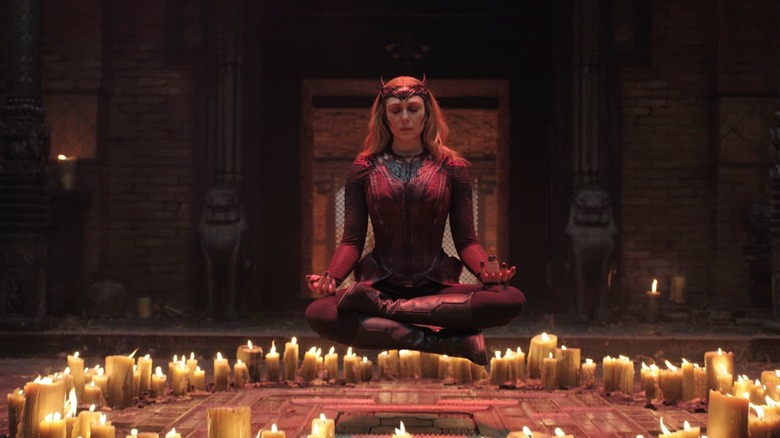It’s long been known that “Doctor Strange in the Multiverse of Madness” underwent some behind-the-scenes changes when original director Scott Derrickson departed in 2020, to be replaced by Sam Raimi. What those changes were, though, and indeed what Derrickson had planned in the first place, remained unclear… until, it seems, now.
“X-Men ’97” creator and former showrunner Beau DeMayo (fired shortly before the show’s premiere, reportedly for workplace and sexual misconduct) has shared details on X/Twitter. Apparently, big changes were made during rewrites to the Wanda Maximoff/Scarlet Witch (Elizabeth Olsen), turning her from supporting hero to villain.
Recap time: Wanda — once an Avenger — went a little mad with grief after Thanos (Josh Brolin) murdered her android lover Vision (Paul Bettany) back in “Avengers: Infinity War.” In Disney+ series “WandaVision,” she let loose her reality-warping powers to another level, brainwashing the town of Westview, New Jersey to make an idyllic sitcom-life for herself and a magical facsimile of Vision. “Multiverse of Madness” carries on from there, with Wanda trying to reunite with her fake children, Tommy and Billy, from Westview with the help (willing or not) of dimension-hopping teen America Chavez (Xochitl Gomez).
Raimi’s “Multiverse of Madness” is about Doctor Strange (Benedict Cumberbatch) protecting America from Wanda. DeMayo, though, says earlier drafts would’ve been a different kind of sequel to “WandaVision” (backing up a claim first made by scooper MyTimeToShineHello). Rather than a predator hunting America Chavez, Wanda (guilt-stricken from her actions at Westview), would be her mentor. The villain of the film would be not Wanda, but Nightmare, a Darkhold-corrupted variant of Doctor Strange.
Scarlet Witch wasn’t originally the villain in Multiverse of Madness
According to DeMayo, this unrealized “Multiverse of Madness” draft would have had a cliffhanger ending. After the heroes beat Nightmare, however, Wanda would be unable to let go of the reality she saw her children in. Diving back into the multiverse, she would accidentally kill Wong (Benedict Wong) when he tries to stop her. The film would end with an apologetic Wanda leaving Strange alone with Wong’s body.
These are both, at best, second hand sources, so if you’re wary, I understand. For what it’s worth, though, Derrickson had been saying since 2016 (when the first “Doctor Strange” film came out) that Nightmare would be his pick for the sequel villain. Nightmare, lord of the Dream Dimension, nourishes himself by tormenting humans in their sleep. In essence an elven Freddy Krueger, Nightmare is a villain right out of Derrickson’s horror films like “Sinister” or “The Black Phone.”
Marvel wanting to use Scarlet Witch as the film’s villain instead of Nightmare? That seems like a big enough creative conflict (or at least symptomatic of even larger ones) that could make Derrickson throw his hands up and leave. “Multiverse of Madness” also introduces a concept called “Dreamwalking”: that our dreams are actually visions of our lives in parallel universes. Perhaps this is a leftover from drafts that had a nightmare-themed villain? Likewise, the twist that Nightmare was actually an evil Stephen Strange variant? That description also fits the character dubbed “Sinister Strange,” who is in the final version of “Multiverse of Madness.”
Is there a Scarlet Witch redemption coming in the MCU?
Wanda’s villainous role in “Multiverse of Madness” remains divisive within the MCU fandom. Some say the movie retreads the beats of “WandaVision” too much, making Wanda’s arc repetitive and undermining the show. (It doesn’t help that, per Elizabeth Olsen, “Multiverse of Madness” writer Michael Waldron hadn’t seen “WandaVision.”) Others think the Scarlet Witch got off too lightly without properly atoning in “WandaVision,” so her sinking further into darkness tracks.
The Marvel Cinematic Universe has a problem with consistent character arcs (unless your name is Nebula or Rocket Raccoon) and Wanda is an obvious case of that. Along with abrupt shifts in her characterization, it took the movies six years to give Olsen’s Wanda the right costume or name. Changing “the Scarlet Witch” from her superhero name into a prophesied figure in the Darkhold, Book of the Damned? One of the most egregious Surf Draculas in the MCU.
But hey, Scarlet Witch’s Marvel Comics history is plenty messy too — especially once Brian Michael Bendis started writing her in the 2000s. MCU Wanda’s maniacal, baby-fever-induced reality-warping in the movies is indebted to Bendis’ “Avengers: Disassembled” and “House of M.” The latter gave us Wanda’s most famous line — “No More Mutants,” three words that reduce the world’s mutant population from almost a million to 200. Wanda, no longer a mutant thanks to some MCU-induced retcons, was dubbed the Great Pretender by mutant-kind for her actions. When she tried to make it right in “Empyre: X-Men” by magically resurrecting the slaughtered mutant nation Genosha? She unleashed a zombie apocalypse instead.
“Multiverse of Madness” ends with Wanda seemingly perishing — but is that it for her in the MCU? Or is there a resurrective redemption coming? The latest issue of Production Weekly lists a “Scarlet Witch” project as in the works. With how controversial Wanda’s walk on the dark side has been, Marvel Studios would probably want to pivot her back to a more heroic character. Perhaps this could take cues from Steve Orlando’s ongoing “Scarlet Witch” comic series, where Wanda owns a magic shop with a magical, dimension-hopping door.
Joe Locke’s unnamed character in “WandaVision” spin-off “Agatha All Along” is widely speculated to be Billy Kaplan/Wiccan, or the grown-up version of Wanda son Billy. Maybe the MCU will be recreating this moment from Allan Heinberg and Jim Cheung’s “The Children’s Crusade” soon.
Whether as heroine or villain, it seems Wanda Maximoff may be dream-walking back into the MCU soon.
